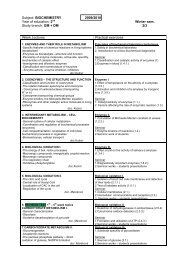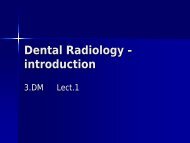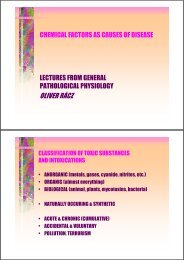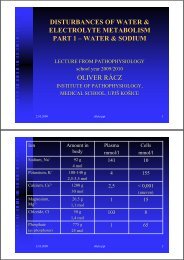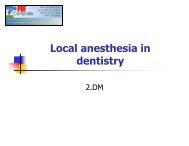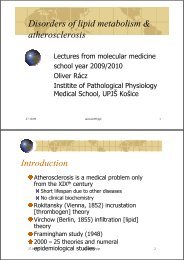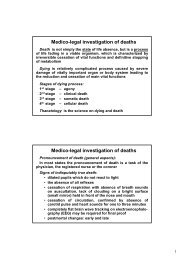Questions for oral exam in oral biochemistry Dental Medicine - TOP ...
Questions for oral exam in oral biochemistry Dental Medicine - TOP ...
Questions for oral exam in oral biochemistry Dental Medicine - TOP ...
Create successful ePaper yourself
Turn your PDF publications into a flip-book with our unique Google optimized e-Paper software.
<strong>Questions</strong> <strong>for</strong> <strong>oral</strong> <strong>exam</strong> <strong>in</strong> <strong>oral</strong> <strong>biochemistry</strong><br />
<strong>Dental</strong> Medic<strong>in</strong>e<br />
1. Enzymes – general characteristics, structure, and function<br />
2. Factors affect<strong>in</strong>g the reaction rate of enzymatically catalyzed reactions<br />
3. Inhibition of enzymatic reactions. Michaelis-Menten constant K m<br />
4. Allosteric enzymes - effectors and <strong>in</strong>hibitors<br />
5. Nam<strong>in</strong>g and classification of enzymes<br />
6. Coenzymes and cofactors<br />
7. Significance of enzyme specifity (e.g. isoenzymes)<br />
8. Enzymatic activity and its determ<strong>in</strong>ation<br />
9. General mechanism of the regulation of catalytic activity <strong>in</strong> liv<strong>in</strong>g systems<br />
10. Activation and <strong>in</strong>activation of enzymatic activity<br />
11. Respiratory cha<strong>in</strong> and its enzymes<br />
12. Citric acid cycle<br />
13. Anaplerotic reactions and energetic of citric acid cycle<br />
14. Enzymes of the citric acid cycle - regulation<br />
15. The cell and its <strong>in</strong>termediatory metabolism<br />
16. Endergonic and exergonic reactions <strong>in</strong> metabolism<br />
17. ATP-ase - structure, <strong>in</strong>hibitors of oxidative phosphorylation<br />
18. Biologic oxidation (e.g. oxidase, oxygenase, peroxidase and dehydrogenase)<br />
19. Macroergic compounds and their roles <strong>in</strong> metabolism<br />
20. Formation and metabolic role of acetyl-CoA<br />
21. Glucose-6-P - its roles <strong>in</strong> metabolism<br />
22. Synthesis and roles of glucuronic acid<br />
23. Glycolysis and its energetic balance<br />
24. Peculiarities <strong>in</strong> metabolism of glucose <strong>in</strong> erythrocytes<br />
25. Gluconeogenesis and its regulation<br />
26. Metabolism of monosaccharide’s (e.g. galactose, fructose)<br />
27. Disorders <strong>in</strong> saccharide metabolism<br />
28. Metabolic pathways of pyruvic acid (e.g. pyruvatedecarboxylase)<br />
29. Cori cycle and glucose-alan<strong>in</strong>e cycle<br />
30. Biosynthesis and degradation of oligosaccharides<br />
31. Pentose phosphate cycle<br />
32. Glycogen synthesis and its regulation<br />
33. Glycogenolysis and its regulation, disorders<br />
34. Metabolism of am<strong>in</strong>osugars<br />
35. Digestion and absorption of sugars<br />
36. Degradation of triacylglycerols<br />
37. Beta-oxidation of fatty acids<br />
38. Other types of fatty acid oxidation<br />
39. Biosynthesis of saturated fatty acids and triacylglycerols<br />
40. Biosynthesis of unsaturated fatty acids and triacylglycerols<br />
41. Phospholipids (e.g. clalssification, roles, biosynthesis)<br />
42. Digestion, absorption and catabolism of complex lipids<br />
43. Sph<strong>in</strong>golipids, cerebrosides, gangliosides and metabolic disorders<br />
44. Lipoprote<strong>in</strong>s, mucoprote<strong>in</strong>s and glycoprote<strong>in</strong>s – biological functions<br />
45. Formation and degradation of ketone bodies<br />
46. Eicosanoids – classification, metabolism and their biologic roles<br />
47. Biosynthesis of cholesterol ant its roles<br />
48. Bile acids, biosynthesis and importance<br />
49. Biosynthesis of vitam<strong>in</strong> D, function and disorders<br />
50. Biological function, composition and degradation of chylomicrons, VLDL, LDL and HDL<br />
51. Disorders <strong>in</strong> lipid metabolism
52. Nitrogen sources (nitrogen balance, prote<strong>in</strong>s)<br />
53. Ma<strong>in</strong> reactions of am<strong>in</strong>o acid catabolism<br />
54. Essential and nonessential am<strong>in</strong>o acids and their importance <strong>in</strong> metabolism<br />
55. Formation of ammonia <strong>in</strong> the organism and its fate. Transport and detoxification of ammonia<br />
56. Urea synthesis (regulation, disorders)<br />
57. Am<strong>in</strong>o acids metabolized through pyruvate (synthesis, degradation, disturbances)<br />
58. Am<strong>in</strong>o acids metabolized through oxaloacetate (synthesis, degradation, disturbances)<br />
59. Am<strong>in</strong>o acids metabolized through acetyl-CoA (synthesis, degradation, disturbances)<br />
60. Am<strong>in</strong>o acids metabolized through 2-oxoglutarate (synthesis, degradation, disturbances)<br />
61. Am<strong>in</strong>o acids metabolized through succ<strong>in</strong>yl-CoA (synthesis, degradation, disturbances)<br />
62. Am<strong>in</strong>o acids metabolized through fumarate (synthesis, degradation, disturbances)<br />
63. Formation and function of NO<br />
64. Trans<strong>for</strong>mation of carbon skeleton of am<strong>in</strong>o acids<br />
65. Catecholam<strong>in</strong>es - <strong>for</strong>mation, functions and degradation<br />
66. Am<strong>in</strong>o acids and peptides as precursors of neurotransmitters<br />
67. Biogenic am<strong>in</strong>es - <strong>for</strong>mation and function<br />
68. Glucogenic am<strong>in</strong>o acids<br />
69. Ketogenic am<strong>in</strong>o acids<br />
70. Role and importance of THF and SAM <strong>in</strong> metabolism<br />
71. Significance of am<strong>in</strong>o acids <strong>for</strong> <strong>for</strong>mation of other compounds<br />
72. Biosynthesis, degradation and regulation of pyrimid<strong>in</strong>e nucleotides<br />
73. Biosynthesis, degradation and regulation of pur<strong>in</strong>e nucleotides<br />
74. Cyclic nucleotides and their importance <strong>in</strong> regulatory reactions<br />
75. Biosynthesis of nucleotide coenzymes (NAD, FAD, CoA)<br />
76. Degradation NA, nucleotides and nucleosides<br />
77. Importance salvage reactions of nitrogen bases and nucleosides<br />
78. Biosynthesis of deoxyribonucleotides (regulation)<br />
79. Relationship between metabolism of sugars, prote<strong>in</strong>s and lipids<br />
80. Disorders <strong>in</strong> nucleotide metabolism<br />
81. Structure of DNA, denaturation and renaturation of DNA<br />
82. Structure of RNA (mRNA, rRNA, tRNA)<br />
83. Arrangement of genetic material <strong>in</strong> DNA, genes, exons and <strong>in</strong>trons, genetic code<br />
84. Biosynthesis of DNA (e.g. regulation, mutation, correct<strong>in</strong>g mechanisms)<br />
85. Biosynthesis of RNA (mRNA, rRNA, tRNA)<br />
86. Proteosynthesis <strong>in</strong> prokaryotic and eukaryotic cells (e.g. <strong>in</strong>itiation, elongation and term<strong>in</strong>ation)<br />
87. Inhibition of proteosynthesis by exogenic substances<br />
88. Regulation of gene expression <strong>in</strong> eukaryotic and prokaryotic cells<br />
89. Gene manipulation (restriction endonucleases, clon<strong>in</strong>g)<br />
90. Posttranslational corrections of peptide cha<strong>in</strong>s, signal peptides<br />
91. Transcription of DNA (e.g. <strong>in</strong>duction, repression, regulation)<br />
92. DNA methods (e.g. amplification - PCR, sequenc<strong>in</strong>g, hybridization)<br />
93. Inhibitors <strong>in</strong> biosynthesis of nucleic acids<br />
94. Digestion of nucleoprote<strong>in</strong>s and nucleic acids <strong>in</strong> the GIT<br />
95. Biosynthesis and degradation of heme (regulation, disorders)<br />
96. Formation of bile pigments, transport and conversion of bilirub<strong>in</strong> <strong>in</strong> the <strong>in</strong>test<strong>in</strong>es<br />
97. Biochemical mechanism of hemocoagulation<br />
98. Prote<strong>in</strong>s of blood plasma<br />
99. Blood, its composition and biochemical function<br />
100. Acid-base balance. Buffer systems<br />
101. Role of water <strong>in</strong> metabolism and nutrition<br />
102. Transport of O 2 and CO 2 , role of blood <strong>in</strong> respiration<br />
103. Disorders <strong>in</strong> ABB (kidney, liver, lungs role <strong>in</strong> ABB ma<strong>in</strong>tenance)<br />
104. Metabolism of xenobiotics, types of biotrans<strong>for</strong>mation reactions
105. Mechanisms of hormone action<br />
106. Mediators – neurotransmitters<br />
107. Fundamental components of food, their role and energetic value<br />
108. Digestion of prote<strong>in</strong>s <strong>in</strong> the GIT and reabsorbtion of cleaved products<br />
109. Digestion <strong>in</strong> mouth and stomach<br />
110. Digestion <strong>in</strong> small <strong>in</strong>test<strong>in</strong>e<br />
111. Biochemistry of muscle contractions<br />
112. Biochemistry of sk<strong>in</strong><br />
113. Biochemistry of neural tissue<br />
114. Composition and metabolism of hard tissue (bones, teeth)<br />
115. Extracellular matrix (connective tissue – collagen, GAG)<br />
116. Metabolism of Ca, regulation and disorders<br />
117. The <strong>in</strong>fluence of diet on the metabolism of teeth<br />
118. Dietary requirements, basal metabolism, balanced diet<br />
119. Enamel <strong>for</strong>mation and properties<br />
120. Pellicle, plaque and carries <strong>for</strong>mation<br />
121. Prevention of tooth carries<br />
122. Role of saliva<br />
123. Tongue and taste receptors<br />
124. Factors affect<strong>in</strong>g reliability of biochemical results and their <strong>in</strong>terpretation<br />
125. Biological material and its process<strong>in</strong>g <strong>in</strong> cl<strong>in</strong>ical <strong>biochemistry</strong>




